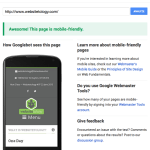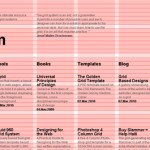In one of our most recent email newsletters, we pointed readers to Google’s Mobile-Friendly Test so that people could check to make sure their sites weren’t being penalized. This link was far and away the hottest item in the email, with over 400% more clicks than any other link in the newsletter.
In spite of Google’s attempts at emphasizing the importance of mobile-friendly design, and later on their tough-love warnings that your sites will be punished after April 21st, the message seems clear to us: people, businesses, and their websites are being left behind and many are unsure what to do to catch up.
Some may breathe a sigh of relief upon receiving a passing mark from the test, but what if you’re left with a big, fat F?
Over at our agency, The Next Wave, we commonly receive requests to “add responsiveness to our existing site.” We understand that this kind of request comes from a good place: folks who are looking for an inexpensive and painless way into the mobile-friendly realm by “adding on” the mobile functionality.
The problem is that this is actually pretty difficult, in some cases impossible, to achieve from a designer and developer’s perspective.
Mobile-friendly designers will typically start designing a website by how it looks like on mobile devices, then expanding and scaling the design outwardly from there. The idea is that everyone will be looking at essentially the same website, and there is no inferior way to browse.
Mobile-friendly developers mostly code websites as a giant grid to complement this aforementioned approach to design. For instance, each item on a typical WordPress site: posts, sliders, headlines, forms, and etc. are placed inside various squares of a grid. This makes it very easy to scale websites. As the screen becomes larger and smaller, you can shift the grid around so that everything still fits, but the code itself stays the same underneath.
Most developers who are giving an old site true responsiveness are essentially coding a new site from scratch but still wrapping it up in your design that looked good back in 2010. It makes more sense to just go back to the drawing board and start fresh.
By now I can feel your frustration coming through. You’re likely thinking, “This is all well-and-good, but I still can’t afford the time/money to invest in a brand new website right now.” You might even be thinking that there’s nothing wrong with your site as it is, except for Google’s stupid new rule.
If you’re a WordPress user, there are a few plugins out there that can take your pages, posts, etc. and wrap it in a separate mobile site. Notably WPTouch—with a couple free themes—and the mobile theme feature in Jetpack. Desktop users will still see your same-old site, and mobile users will be served up something different.
Keep in mind, however, that your mobile users will be looking at an inferior version of your site that might not work very well. Eventually, you’ll have to move on.
It’s not as intimidating as it seems, we promise. In fact, you could do it yourself over a long weekend. That’s what our seminar can show you.
Mozilla is a global non-profit dedicated to putting you in control of your online experience and shaping the future of the Web for the public good. When you use Firefox, you’re supporting that mission and making the Web better for everyone!
The video below explains more about Mozilla’s non-profit ideals and the spirit behind our mission. Enjoy!
via About Mozilla
The above video explains the brief history of the web, and more specifically the history of Mozilla. It achieves this by utilizing eye-catching motion graphics and animations. The video is useful and relevant for it’s brief history of the web, and is a great demonstration about the impact that a video can have on your site. It’s easy to forget the days of dial-up internet connection, AOL, spam popups on every website, etc. The web experience is very different than it was 15, 10, and even 5 years ago. Gone are the days of building a Geocities website in Notepad. Companies like Mozilla are pushing the web in a new direction at a very rapid rate.
The video is also valuable to Mozilla not only because of its effectiveness in creating a sense of community for its users, but also because the goal of the video is to get donations. It’s only after we get the the emotional impact of the video that we are asked to donate, which in my opinion is much more effective than a few paragraphs from the guy who invented the wiki. Mozilla tells us that they are here to build a better internet, and while they are doing so they will continue to make their products available for free to their customers. It’s hard to argue with that – I am writing this post in a Firefox browser and checking my mail on Thunderbird, both of which are free.
These are the tools that are available to us. To be a part of the web community and, more importantly, get people interested in what we are doing, we should capitalize on these tools.
Sometimes it’s just better to say- here is where someone got it all together- and tell you to click over and read their post.
This is one of them- the presentations on this site will help make it clear to you, enjoy:
Web 1.0 – That Geocities & Hotmail era was all about read-only content and static HTML websites. People preferred navigating the web through link directories of Yahoo! and dmoz.
Web 2.0 – This is about user-generated content and the read-write web. People are consuming as well as contributing information through blogs or sites like Flickr, YouTube, Digg, etc. The line dividing a consumer and content publisher is increasingly getting blurred in the Web 2.0 era.
Web 3.0 – This will be about semantic web (or the meaning of data), personalization (e.g. iGoogle), intelligent search and behavioral advertising among other things.
via What is Web 3.0? Semantic Web & other Web 3.0 Concepts Explained in Plain English.



